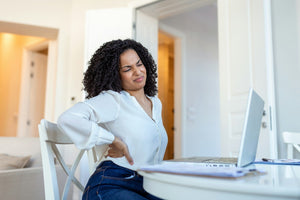Understanding Sore Muscles and Joint Pain
Sore muscles and joint pain are common complaints affecting people of all ages and lifestyles. They can result from overuse, injury, poor posture, or underlying medical conditions.
For aching joints, various therapeutic techniques and treatments such as heat and cold applications, physical activity, posture correction, and the use of assistive devices can provide relief.
While muscle pain is often temporary and related to physical activity, joint pain can stem from chronic conditions such as arthritis, osteoarthritis, or rheumatoid arthritis.
Key Differences Between Muscle and Joint Pain:
-
Muscle Pain: Often caused by overuse, strain, or injury. It typically improves with rest, stretching, and gentle care.
-
Joint Pain: Can stem from inflammation, cartilage breakdown, or autoimmune diseases. It often requires targeted treatment and lifestyle adjustments.
Why Understanding the Cause Matters:
Identifying the root cause of pain is essential for effective treatment. Understanding the root cause of arthritis pain is crucial for effective treatment, as it allows for targeted strategies that can significantly improve quality of life.
Whether it’s a sports injury, poor ergonomics, or a chronic condition, the right approach can provide long-term relief and prevent further complications.
What Causes Sore Muscles?
Sore muscles, also known as myalgia, can have a variety of causes:
1. Muscle Strain and Overuse:
-
Excessive exercise or physical activity can cause micro-tears in muscle fibers, leading to soreness.
-
Improper lifting techniques or repetitive movements can result in muscle strain.
2. Poor Posture and Body Mechanics:
-
Sitting for prolonged periods with poor posture can strain muscles in the neck, shoulders, and lower back.
-
Incorrect ergonomics at workstations can exacerbate muscle pain.
3. Medical Conditions:
-
Fibromyalgia: Causes widespread muscle pain and tenderness.
-
Chronic Fatigue Syndrome: Persistent fatigue accompanied by muscle aches.
-
Autoimmune Disorders: Conditions like lupus and polymyositis can cause chronic muscle pain.
4. Infections and Other Factors:
-
Viral infections (e.g., flu) can cause body aches.
-
Dehydration and nutritional deficiencies can also trigger muscle cramps and soreness.
Treating Muscle Pain
Muscle pain can often be managed at home with a combination of rest, medications, and gentle therapies.
1. Rest and Recovery:
-
Allow sore muscles time to recover after strenuous activity.
-
Avoid activities that aggravate the pain.
2. Over-the-Counter Pain Relievers:
-
NSAIDs: Nonsteroidal anti-inflammatory drugs (NSAIDs) such as ibuprofen and naproxen sodium are useful for relieving pain and inflammation. They are available over-the-counter and can be more effective at higher prescription doses.
-
Acetaminophen: Helps with pain but does not reduce inflammation.
3. Prescription Medications:
-
Muscle relaxants may be prescribed for severe muscle spasms. Stronger pain relievers might be necessary for chronic or intense pain. For managing chronic pain, it is crucial to select the appropriate medication from various categories, such as oral medications, disease-modifying agents, and topical treatments. Medications like duloxetine are specifically approved to treat chronic pain related to conditions like osteoarthritis.
4. Physical Therapy:
-
A physical therapist can create a personalized exercise program to improve muscle strength and flexibility. Gentle stretching exercises can alleviate tension.
Medications and Supplements for Pain Relief
Combining medications and supplements can be an effective approach to managing both muscle and joint pain.
1. NSAIDs:
-
Reduce inflammation and pain.
-
Examples: Ibuprofen (Advil), Naproxen (Aleve).
2. Muscle Relaxants:
-
Alleviate muscle spasms and tension.
-
Often used for acute injuries or severe cramping.
3. Supplements for Joint Health:
-
Glucosamine and Chondroitin: Promote cartilage health and reduce joint pain.
-
Turmeric: Contains curcumin, a natural anti-inflammatory compound.
-
Magnesium: Helps relax muscles and prevent cramps.
4. Topical Creams and Ointments:
-
Capsaicin Cream: Reduces pain by blocking nerve signals. It is particularly effective for alleviating pain directly on the affected area of a painful joint.
-
Arnica Gel: Known for its anti-inflammatory properties.
Relieve Joint Pain with Exercise and Therapy
1. Gentle Exercises:
-
Yoga: Improves flexibility and reduces stiffness.
-
Swimming: Low-impact activity that strengthens muscles without straining joints.
-
Walking: Boosts mobility and maintains joint health.
2. Strengthening Exercises:
-
Building muscle strength around joints provides better support and reduces pain.
-
Focus on exercises that target the core, knees, and hips.
3. Physical Therapy:
-
Customized plans for improving joint mobility, flexibility, and stability. A physical or occupational therapist can develop tailored exercise programs and adapt activities to improve mobility and reduce joint pain.
-
Techniques like manual therapy can reduce pain and inflammation.
4. Occupational Therapy:
-
Helps individuals adapt daily activities to reduce joint stress and prevent pain flare-ups.
-
Ergonomic adjustments in workspaces can make tasks more manageable.
Natural Remedies for Sore Muscles and Joint Pain
Natural remedies can complement traditional treatments for sore muscles and joint pain relief.
1. Topical Solutions:
-
Cream: Anti-inflammatory and pain-relieving properties.
-
Arnica Gel: Reduces swelling and bruising.
-
Capsaicin Cream: Blocks pain signals.
2. Heat and Cold Therapy:
-
Heat Therapy: Helps relax muscles and improve circulation.
Heat and cold therapy can target both pain and inflammation, providing comprehensive relief for chronic conditions.
-
Cold Therapy: Reduces swelling and numbs sharp pain.
3. Massage and Acupuncture:
-
Massaging sore muscles increases blood flow and relieves tension.
-
Acupuncture targets specific pressure points to reduce muscle pain. For those experiencing severe pain despite standard pain medications, acupuncture can be a beneficial therapy to alleviate significant discomfort.
4. Herbal Supplements:
-
Turmeric: Natural anti-inflammatory.
-
Ginger: Reduces muscle soreness.
-
Omega-3 Fatty Acids: Found in fish oil, they reduce joint inflammation.
Ease into Exercise Safely
1. Start Slowly:
-
Begin with low-impact exercises and gradually increase intensity.
2. Warm-Up and Cool Down:
-
Warm up with light stretches and dynamic exercises.
-
Cool down with gentle flexibility routines.
3. Listen to Your Body:
-
Avoid pushing through sharp or persistent pain.
4. Seek Professional Guidance:
-
Work with a physical therapist or fitness trainer to design a safe exercise program.
Alternative Therapies for Pain Management
1. Chiropractic Care:
-
Aligns the spine and reduces pressure on joints and muscles.
2. Acupuncture:
-
Restores energy flow (Qi) and reduces pain perception.
3. Massage Therapy:
-
Releases muscle tension and improves circulation.
4. Mind-Body Practices:
-
Meditation and Mindfulness: Reduce stress, improve pain tolerance, and relieve pain by promoting relaxation and mental clarity.
-
Cognitive-Behavioral Therapy (CBT): Helps reframe negative pain-related thoughts.
Diet and Nutrition for Joint Health
1. Anti-Inflammatory Diet:
-
Include leafy greens, berries, fatty fish, and whole grains.
-
Avoid processed foods, sugary drinks, and excessive salt.
2. Omega-3 Fatty Acids:
-
Found in salmon, chia seeds, and walnuts.
3. Hydration:
-
Stay hydrated to maintain joint lubrication and flexibility.
Safety and Efficacy
Consult with Your Doctor:
-
Share your medical history and medications.
-
Discuss potential side effects and interactions.
Monitor Progress:
-
Use a pain journal or mobile app to track symptoms.
-
Adjust treatments based on your body's response.
Frequently Asked Questions
1. What is the best pain relief for muscle and joint pain? NSAIDs, heat therapy, and topical creams are highly effective.
2. How do you treat sore muscles ASAP? Rest, apply ice or heat, and use over-the-counter pain relievers.
3. Why do my muscles and joints hurt so bad? Pain can result from overuse, inflammation, or chronic medical conditions.
4. What is throbbing pain in arthritis? Throbbing pain is a debilitating form of arthritis pain that sufferers experience. This type of pain can be exacerbated by activity or stress and highlights the need for effective pain management options. Understanding throbbing pain is essential in addressing the complexities of arthritis.
Effective Sore Muscles and Joint Pain Relief Conclusion
Managing sore muscles and joint pain requires a multifaceted approach, combining medications, supplements, exercise, and natural therapies.
By identifying the root cause, consulting healthcare professionals, and adopting consistent self-care practices, you can effectively alleviate pain and improve your quality of life.
Stay active, nourish your body, and seek professional guidance when necessary—relief is within reach!


